1
Way back in the early 1950s, black and white television sets were becoming more popular in North America as production numbers increased and the price came down. More and more families puchased their first TV set. One trigger was the televised coronation of Queen Elizabeth II in 1953.Apparently the earliest TV sets did not have a very bright picture, so the viewing room had to be dark. People were advised, often by store salemen, to purchase a "TV lamp". These low-wattage lamps would provide subdued lighting near the television screen to reduce eye strain (or so the story goes). For whatever reason, the market grew rapidly for TV lamps of many designs made with various materials, including china cases of various animals. It has been suggested that the pottery industry was saved in the 1950s because of this new product.
Today, TV lamps have become serious collectibles. There is at least one major web site on the Internet devoted to TV lamps - check out www.tvlamps.net.
Not many companies made TV lamp CLOCKS, an ingenious combination of two critical functions for your TV viewing room. Some American companies such as United, Gibralter, and Tele-Vision sold a few models. Harry Snider tackled this new market in the 1950s with three styles of TV lamp clock. One was based on typical china cases (panthers, horses) molded and painted for him by companies in Toronto. A large, low-wattage light bulb with on/off switch was mounted in the back so that the light would bounce off the wall behind the lamp and also, for some models, diffuse through a layer of translucent material incorporated into the front of the case (Pictures 2 to 5 in this Storyline).
A second Snider style included wooden-hulled models of boats with one or two small, low-wattage bulbs. The flat (Picture 6) or curved (Picture 7) sails were made of chrome-plated sheet metal. Some of the three-masted boats turn up with the original string rigging (Picture 7). Other examples where Harry used wood include a horse/horseshoe clock with a lamp and shade mounted on the base (Picture 8) and a fireplace design with a small, coloured bulb behind the molded-metal logs (Picture 9).
And then there was a very strange lamp/clock combination that included what looked like a telephone (Picture 10). However, there is an electric clock where the dial should be in the cast-metal case. The handset has a button at the upper end and a layer of mineral mica at the speaking end, underneath which is a small electric heater element. So the handset functions in fact as a push-button cigarette lighter! According to Michael Snider, these triple-function products were very popular in the years around 1960, several decades before the serious health hazards of smoking tobacco were confirmed. Do you like the light green colour with the black speckle finish? You could also choose white with the black speckle, or fire-engine red with the black speckle! The colour-matched lamp shades were made from lengths of the wide, curved metal strips used in venetian blinds for windows at that time.
The most unusual Snider TV lamp clocks were the three metal-cased models that Harry Snider designed and then registered in Canada in 1957. These were his models 503 ("butterfly" - author's description, Pictures 11 to 14), 504 ("in-car heater", Picture 15), and 505 ("squashed diamond", Pictures 16 and 17). These three models were available in five colours: black, sandalwood (brown), and white (? usually found now looking ivory or cream-coloured), and the characteristic 1950s pink and turquoise. The museum's Snider collection currently includes all five colours for the 503 and two each for the 504 and 505. No other company made these unique styles.
The model 500 was Harry's Snider Spider wall clock (see main exhibit). The museum has not yet identified the clocks associated with model numbers 501 and 502.
It seems that the consumer demand for TV lamps, and therefore TV lamp clocks, slowly disappeared by the end of the 1950s, by which time the brightness levels of TV sets had increased significantly. A very dark room was no longer necessary for good picture quality. So 1960 marked the end of an era - TV lamp clocks, and mantel clocks in general, were no longer included in Snider Clock Mfg Co catalogues by the early 1960s. The large and expanding market for wall clocks had become their focus.
2
Dark green china-cased TV lamp electric clock, Snider Clock Corporation.mid 1950s
The Canadian Clock Museum, Deep River, Ontario
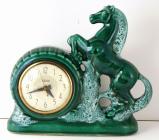 Credits:
Credits:The Canadian Clock Museum
3
Black panthers electric TV lamp clock, Snider Clock Corporation.mid 1950s
The Canadian Clock Museum, Deep River, Ontario
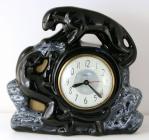 Credits:
Credits:The Canadian Clock Museum
4
The green version of the panthers TV lamp electric clock, Snider Clock Corporation.mid 1950s
The Canadian Clock Museum, Deep River, Ontario
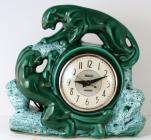 Credits:
Credits:The Canadian Clock Museum
5
Brown china horse TV lamp electric clock, Snider Clock Corporation.mid 1950s
The Canadian Clock Museum, Deep River, Ontario
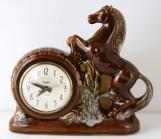 Credits:
Credits:The Canadian Clock Museum
6
Single-mast, flat-sails electric boat clock with cabin light, Snider Clock Corporation.mid 1950s
The Canadian Clock Museum, Deep River, Ontario
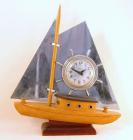 Credits:
Credits:The Canadian Clock Museum
7
Rigged three-masted boat electric mantel clock with small lights, Snider Clock Corporation.mid 1950s
The Canadian Clock Museum, Deep River, Ontario
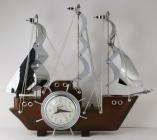 Credits:
Credits:The Canadian Clock Museum
8
An unusual combination of horse/horseshoe clock and lamp, Snider Clock Corporation (electric).mid 1950s
The Canadian Clock Museum, Deep River, Ontario
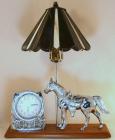 Credits:
Credits:The Canadian Clock Museum
9
Electric fireplace wood mantel clock with small coloured light, Snider Clock Corporation.mid 1950s
The Canadian Clock Museum, Deep River, Ontario
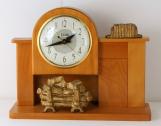 Credits:
Credits:The Canadian Clock Museum
10
An electric clock and lamp with an unusual function (NOT a telephone), Snider Clock Mfg Co.late 1950s early 1960s
The Canadian Clock Museum, Deep River, Ontario
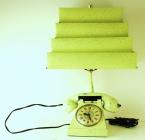 Credits:
Credits:The Canadian Clock Museum
11
Ivory version of model 503 TV lamp electric clock, Snider Clock Mfg Co.late 1950s early 1960s
The Canadian Clock Museum, Deep River, Ontario
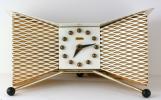 Credits:
Credits:The Canadian Clock Museum
12
Pink version of model 503 TV lamp electric clock, Snider Clock Mfg Co.late 1950s
The Canadian Clock Museum, Deep River, Ontario
 Credits:
Credits:The Canadian Clock Museum
13
Turquoise version, model 503 metal TV lamp electric clock, Snider Clock Mfg. Co.late 1950s
The Canadian Clock Museum, Deep River, Ontario
 Credits:
Credits:The Canadian Clock Museum
14
Back of brown version model 503 TV lamp electric clock, Snider Clock Mfg Co.late 1950s
The Canadian Clock Museum, Deep River, Ontario
 Credits:
Credits:The Canadian Clock Museum